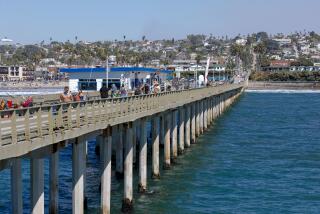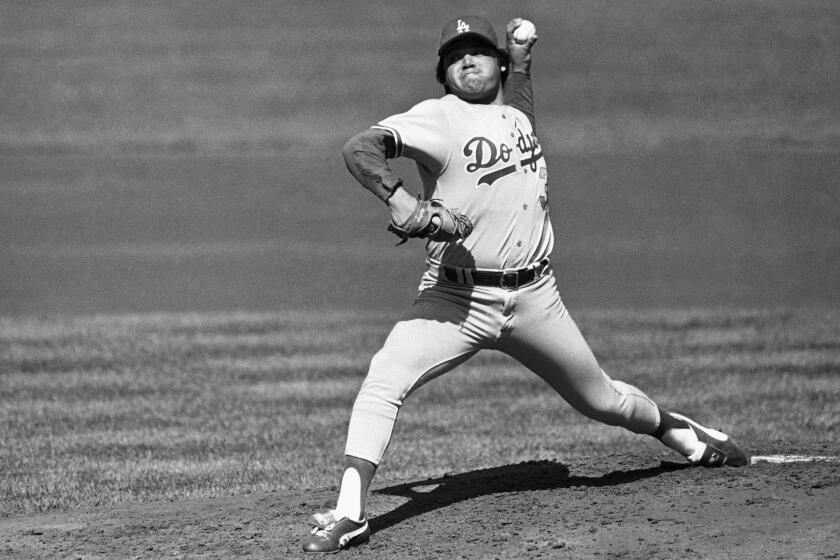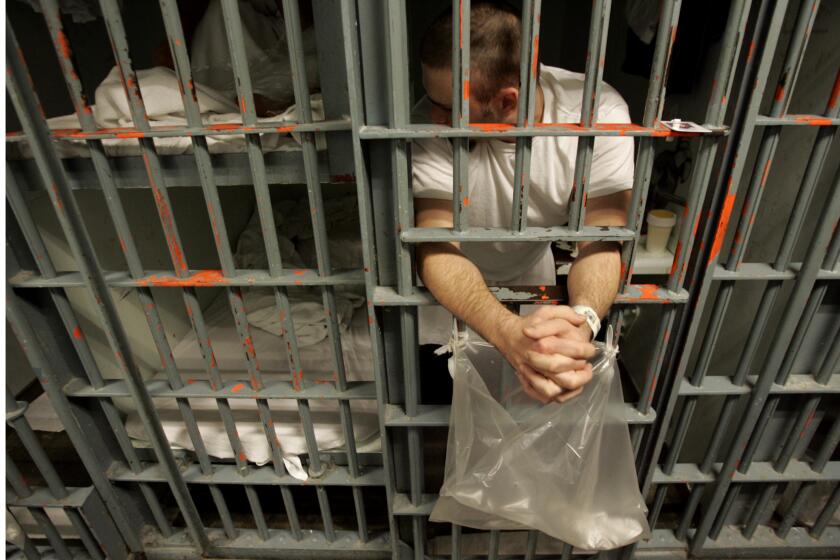Simon Rodia was an eccentric day laborer...
Simon Rodia was an eccentric day laborer who started tinkering in his garden with concrete, bits of colored tile, glass and shells and ended up building a set of spiraling towers that became Watts’ most distinguished landmark, a historical monument recognized around the world as a symbol of Los Angeles.
But he was not an engineer, and he did not rely on blueprints, bolts, rivets or a welding torch. Instead he built the Watts Towers with common rebar, chicken wire and whimsical intuition.
That explains why the towers suffered nearly $2 million in damage from the 1994 Northridge earthquake, requiring the landmark’s most extensive restoration job ever. That also partly explains why visitors have been deprived of access for more than six years to one of the world’s most unusual works of public art.
The original completion deadline for the work passed three years ago, and the repair costs have already doubled from the initial $1-million estimate. The repairs are scheduled to be finished in April 2001, but weekend tours may begin as early as December.
However, city officials are already planning yet another renovation job, lasting 1 1/2 more years, during which some portions of the landmark may at times be closed again to the public.
The slow pace of the work--a combination of seismic retrofitting and delicate art restoration--has frustrated Watts activists and tower enthusiasts who say it has hampered efforts to promote tourism in the economically depressed area and has limited the public’s exposure to the icon.
“You have folks from Italy, New Zealand and South Africa coming here, and they want to see the towers and they are covered,” said Mark Greenfield, director of the Watts Towers Art Center, a hub for cultural events that is at the base of the towers and has remained open throughout the repairs.
Officials concede that bureaucratic funding delays have slowed the pace of the work at the state-owned, but city-managed, landmark. But the work has progressed slowly, they contend, mainly because of the unusual nature of the repairs.
City preservationists say they are replacing rusting rebar, which is more commonly used inside concrete as reinforcement, welding torn joints and driving 16-foot support beams into the earth to help the towers withstand future quakes. All this has been done, they say, while they try to preserve Rodia’s magical tile work on the towers’ spidery legs.
“We are not making hamburgers around here,” said Zuleyma Aguirre, the project’s on-site curator. “This is not McDonald’s.”
The frustration is understandable.
The current efforts, paid for by the Federal Emergency Management Agency and managed by the Los Angeles Cultural Affairs Department, represent the third repair job on the towers since 1979. Since then, state- and city-funded crews have worked intermittently to repair damage from exposure, erosion and vandalism for 20 of the last 21 years.
For much of that time, from 1988 until today, there have been no regularly scheduled tours of the towers--located at East 107th Street, just east of Graham Avenue and an easy walk from the 103rd Street Blue Line train station.
The repair work “is probably unusual in the time that it is taking because this is an unusual landmark,” said Kenneth Bernstein, director of preservation issues for the Los Angeles Conservancy. “This is an extremely complex set of structures with a unique set of technical challenges.”
The towers consist of 17 structures, including three spires (the tallest is 99 1/2 feet tall), four smaller pinnacles, several fountains, bird baths and a gazebo, all built by hand by Rodia, a diminutive and reclusive Italian-born laborer who has been described by some as a genius renegade.
Rodia, who worked on the towers single-handedly from 1921 to 1954, was a peculiar man who once buried his 1928 Hudson automobile near his property because he feared police were after him for using a siren to get through traffic when he was late for work. In 1998, city crews building an outdoor amphitheater next to the towers unearthed the car’s rusted remains.
When asked why he built the towers, Rodia once said: “I had in my mind to do something big, and I did.”
A construction worker by day and an artist by night, Rodia used common laborers’ tools and relied on a window washer’s belt to cling to the towers.
He tied the towers’ joints together with household wire, and he used chicken wire and metal mesh to wrap the bands that extend like ribs around the towers. Rodia then covered the structure with a thin shell of concrete, which he mixed himself. Into the concrete, he pressed more than 11,000 bits of broken pottery, 15,000 pieces of tile, 6,000 chunks of bottle glass and 10,000 sea shells, making the towers appear to have been coated with candy sprinkles.
Rodia died in 1965 in Martinez, Calif.
Preservationists say the towers were not built to withstand years of exposure or Southern California’s notorious earthquakes. Each tower weighs several tons, yet the foundation’s footings extend only 18 inches into the sandy ground beneath the landmark. City crews are adding eight 16-foot beams to the foundation to support the massive structures.
State crews had almost finished a restoration job that began in 1988 when the Northridge earthquake hit in 1994. Curator Aguirre said city officials evaluated the quake damage from the ground, using binoculars to identify cracks. But once city crews built scaffolding and got a close look, she said, they found that the damage was much more extensive.
Aguirre, who is at the site every weekday, said she sympathizes with tourists who routinely complain about the pace of the repairs.
“They get upset and say they were here a year ago and it was still under repair,” she said.
Each section of the towers has been photographed so every piece of tile, glass and sea shell that is removed can be replaced at the exact location using hand-mixed concrete.
“It’s very difficult to repair this work,” said Bud Goldstone, an engineering consultant who has worked on the project since 1959. “You cannot violate the artist’s intent in your repairs.”
Since few private companies were equipped to make such repairs, the city had to spend months training construction workers to perform the job, Goldstone said.
Virginia Kazor, the city’s historic site curator, concedes that the work has been halted for as long as two weeks at a time because of bureaucratic delays in getting funding. But she says she is not sure whether the delays were the fault of the federal agency or the city or both.
On several occasions, funding delays forced Kazor to tap into a trust fund intended for another restoration project elsewhere in the city. When that money ran out, a few of the specially trained workers quit, she said.
Goldstone and Aguirre said the work has also been slowed by efforts to fix damage caused by previous repair jobs. For example, Aguirre said, past crews--she is not sure who--strapped stainless steel beams to the towers’ metal supports, causing a chemical reaction that has accelerated the rusting.
“That is the one principle of restoration: You don’t add anything unless you have documentation,” said Aguirre, an El Salvadoran native who previously worked as conservation chief at that country’s National Museum.
But some tower enthusiasts wonder if the city’s work is altering Rodia’s unique design.
The harshest critic has been film editor William Cartwright, who, with Nick King, a fellow tower enthusiast, bought Rodia’s property from a neighbor who took it over after the artist moved away in 1954. The two men eventually turned the property over to the state.
“I don’t think the beauty of the towers is exhibiting itself if it is covered in scaffolding all of the time,” he said. “I know damn well that if a private firm was working on it, it would have been done.”
Cartwright also questions why the city is adding foundation supports, saying a 1959 stress test proved the towers to be stable.
But Goldstone, who conducted that test, said it did not take into account quakes the magnitude of the 1987 Whittier Narrows temblor (5.9) or the Northridge quake (6.7). Once the current work is completed, city officials plan to seek $250,000 to repair damage caused by erosion and deterioration, separate from the quake damage. But weekend tours should continue during the 1 1/2 years that project takes.
The good news, said Goldstone, is that once that work is completed, the towers should require only minor maintenance in the future.
“What we are doing is art conservation, and what we want to do is keep the Watts Towers up forever--or as long as we can,” he said.
More to Read
Sign up for Essential California
The most important California stories and recommendations in your inbox every morning.
You may occasionally receive promotional content from the Los Angeles Times.











